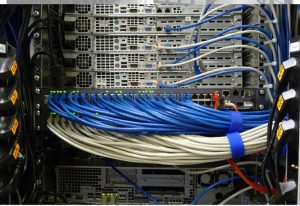A server is engineered to store, manage and process data 24 hours a day, 7 days a week, 356 days a year. Hence, servers need to be far more reliable then our regular desktop or laptop systems. While almost any PC that meets the minimum hardware requirements can run the server operating system, but that doesn't make it a true server. Servers offer a variety of features not typically found in a desktop PC.
There is a specialized hardware for the Servers. It must be robust, as it would be working 24x7 providing requests to the clients. Memory used in the Servers are of very high grade. Hard Drives used for storage are much faster & durable than traditional desktop pcs.
RAID Technology is used for storing the same data on multiple hard disks to increase Read Performance and Fault Tolerance. Hence data remains safe.
If you have uploaded a photograph on Facebook long time ago, you will always find it there and has very less probability of getting it deleted. For redundancy, data is replicated to different data-centers of located in different countries as well, so your data is always safe in the cloud. There is always a best match of hardware inside the servers.
Ever wondered how a real bunch of physical servers looks like:
What's different inside the servers than normal desktops/laptops:
a) Dual processors for faster processing of data.
b) Redundant hard drives and power supplies.
c) Hot swappable components.
d) Could be scalable; to meet current, as well as future needs.
e) Can process data faster and more efficiently.
Servers play a vital role helping us fulfill our day to day needs. A server's responsibility is always to serve its client. When a server fails to serve its client, we call it as server crashed or server down.
Lets understand it with a practical example, as you are reading this blog, the contents of this blog are fetched from website running on Google Server and as you know Server is always on, you can access it anytime from anywhere in the world and give it a quick read.
Common types of Servers used in organizations are:
a) Mail Server: it stores users e-mail accounts and help them send & receives e-mail messages.e.g, Gmail or Hotmail.
b) Web Server (Microsoft IIS, Apache,Nginx): it provides content saved on a disc in the form of website URL.
c) Collaboration Server (Microsoft Sharepoint).
d) Database Servers (Microsoft SQL, MySQL, MariaDB).
e) Proxy Server: A proxy server sits between a client program (typically a Web browser) and an external server (typically another server on the Web) to filter requests, improve performance, and connect to the internet.
How do we access Websites?
Mostly websites are being hosted on Web Hosting Service providers on the internet. They have installed physical servers in their datacenters premises and have scaled them so vast that hundreds of individual websites can be hosted on their servers. It saves huge infrastructure cost & maintenance for the companies taking services from them at a nominal price.
In today's world whatever we are doing on the internet is handled by Servers at backend physically running somewhere in any part of the world. The companies which own these Datacenter Servers maps it using an easy to remember hostnames like Google.com, Facebook.com, Amazon.in etc. If you are calling on a Skype, chatting on Whats App, posting pictures on Facebook, all activities happening at backend are taking place on their respective application server.
Thanks a ton for reading my above blog. I hope it would have been clear about how servers provide us so many services in our day to day life.
Read More on Servers: Click Here
Thanks,
Ajey Kumar Gupta
(Exchange Server Admin).
Next Blog: Why Tempered Glass is not stronger than Gorilla?
There is a specialized hardware for the Servers. It must be robust, as it would be working 24x7 providing requests to the clients. Memory used in the Servers are of very high grade. Hard Drives used for storage are much faster & durable than traditional desktop pcs.
RAID Technology is used for storing the same data on multiple hard disks to increase Read Performance and Fault Tolerance. Hence data remains safe.
If you have uploaded a photograph on Facebook long time ago, you will always find it there and has very less probability of getting it deleted. For redundancy, data is replicated to different data-centers of located in different countries as well, so your data is always safe in the cloud. There is always a best match of hardware inside the servers.
Ever wondered how a real bunch of physical servers looks like:
What's different inside the servers than normal desktops/laptops:
a) Dual processors for faster processing of data.
b) Redundant hard drives and power supplies.
c) Hot swappable components.
d) Could be scalable; to meet current, as well as future needs.
e) Can process data faster and more efficiently.
Servers play a vital role helping us fulfill our day to day needs. A server's responsibility is always to serve its client. When a server fails to serve its client, we call it as server crashed or server down.
Lets understand it with a practical example, as you are reading this blog, the contents of this blog are fetched from website running on Google Server and as you know Server is always on, you can access it anytime from anywhere in the world and give it a quick read.
Common types of Servers used in organizations are:
a) Mail Server: it stores users e-mail accounts and help them send & receives e-mail messages.e.g, Gmail or Hotmail.
b) Web Server (Microsoft IIS, Apache,Nginx): it provides content saved on a disc in the form of website URL.
c) Collaboration Server (Microsoft Sharepoint).
d) Database Servers (Microsoft SQL, MySQL, MariaDB).
e) Proxy Server: A proxy server sits between a client program (typically a Web browser) and an external server (typically another server on the Web) to filter requests, improve performance, and connect to the internet.
How do we access Websites?
Mostly websites are being hosted on Web Hosting Service providers on the internet. They have installed physical servers in their datacenters premises and have scaled them so vast that hundreds of individual websites can be hosted on their servers. It saves huge infrastructure cost & maintenance for the companies taking services from them at a nominal price.
In today's world whatever we are doing on the internet is handled by Servers at backend physically running somewhere in any part of the world. The companies which own these Datacenter Servers maps it using an easy to remember hostnames like Google.com, Facebook.com, Amazon.in etc. If you are calling on a Skype, chatting on Whats App, posting pictures on Facebook, all activities happening at backend are taking place on their respective application server.
Thanks a ton for reading my above blog. I hope it would have been clear about how servers provide us so many services in our day to day life.
Read More on Servers: Click Here
Thanks,
Ajey Kumar Gupta
(Exchange Server Admin).
Next Blog: Why Tempered Glass is not stronger than Gorilla?


0 comments:
Post a Comment